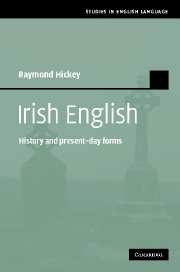3 - History II: The settlement of Ulster
Published online by Cambridge University Press: 14 January 2010
Summary
Background
Any treatment of English in Ireland must take special account of the situation in Ulster. The reason for this lies in the settlement history of this province which led to the introduction of Scots and forms of northern English which were, and still are, distinct from all varieties of English in the south of the country. There has also been, as in the south, interaction between forms of English and Irish which has added a further dimension to the linguistic complexity in the north.
The northern part of Ireland is usually referred to as ‘Ulster’, the most northerly of the four present-day provinces. It literally means the country of the Ulaidh, the people who historically inhabited this area. The word Ulster consists of Ulaidh+s+tír, a Norse-Irish formation, similar to Munster and Leinster, provinces to the south and east respectively. The now opaque compound contains the Irish name of the people, Ulaidh, followed by a Norse genitival /s/ and a phonetically reduced form of /ti:r/, the word for ‘country’ in Irish.
The label ‘Ulster’ is also used loosely today to refer to Northern Ireland, a part of the United Kingdom, which came into existence when Ireland was partitioned in 1921. Northern Ireland consists of six counties – Antrim, Down, Armagh, Derry, Tyrone and Fermanagh – but the province of Ulster actually consists of nine counties: the three additional ones are Donegal (north-west Ulster), Monaghan and Cavan (south Ulster) which are within the Republic, although they are linguistically northern.
- Type
- Chapter
- Information
- Irish EnglishHistory and Present-Day Forms, pp. 85 - 120Publisher: Cambridge University PressPrint publication year: 2007



